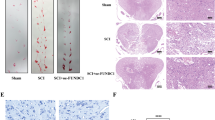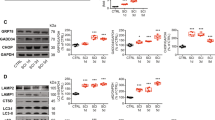Abstract
Necrostatin-1 (Nec-1) has been shown to inhibit necroptosis and convey a significant protective effect after spinal cord injury (SCI). This small molecule inhibitor may reduce tissue damage and restore neurological function by lessening mitochondrial injury after SCI and preserving energy homeostasis. However, the effects of Nec-1 on endoplasmic reticulum stress (ERS)—an important pathological consequence of SCI—are still not clear. The present study investigates the relationship between necroptosis and ERS in a rat model of SCI. Electron microscopy was employed to observe ultra-structural changes in the endoplasmic reticulum and mitochondria after lesioning. Real-time quantitative PCR was used to measure the mRNA levels of ERS-related pro-apoptotic molecules such as C/EBP homologous protein (CHOP), immunoglobulin-binding protein (BiP/GRP78) and X box-binding protein-1 (XBP-1). Western blot and immunofluorescence were conducted to analyze CHOP, GRP78 and XBP-1 protein expression after lesioning. Results demonstrated that applying Nec-1 in SCI reduces ultra-structural damage to the endoplasmic reticulum and mitochondria and inhibits expression of ERS-related genes and proteins after lesioning. Immunofluorescence also shows ERS-related proteins mainly expressed in the cytoplasm of nerve cells. Taken together, these results demonstrate that Nec-1 has protective effect on the endoplasmic reticulum and mitochondria and alleviates ERS after SCI.







Similar content being viewed by others
References
Beattie MS, Farooqui AA, Bresnahan JC (2000) Review of current evidence for apoptosis after spinal cord injury. J Neurotrauma 17(10):915–925
Kanno H, Ozawa H, Tateda S, Yahata K, Itoi E (2015) Upregulation of the receptor-interacting protein 3 expression and involvement in neural tissue damage after spinal cord injury in mice. BMC Neurosci 16:62
Li JS, Zhang W, Kang ZM, Ding SJ, Liu WW, Zhang JH, Guan YT, Sun XJ (2009) Hyperbaric oxygen preconditioning reduces ischemia-reperfusion injury by inhibition of apoptosis via mitochondrial pathway in rat brain. Neuroscience 159(4):1309–1315
Stirling DP, Khodarahmi K, Liu J, McPhail LT, McBride CB, Steeves JD, Ramer MS, Tetzlaff W (2004) Minocycline treatment reduces delayed oligodendrocyte death, attenuates axonal dieback, and improves functional outcome after spinal cord injury. J Neurosci 24(9):2182–2190
Cho YS (2014) Perspectives on the therapeutic modulation of an alternative cell death, programmed necrosis. Int J Mol Med 33(6):1401–1406
Linkermann A, Hackl MJ, Kunzendorf U, Walczak H, Krautwald S, Jevnikar AM (2013) Necroptosis in immunity and ischemia-reperfusion injury. Am J Transplant 13(11):2797–2804
Degterev A, Hitomi J, Germscheid M, Ch’en IL, Korkina O, Teng X, Abbott D, Cuny GD, Yuan C, Wagner G, Hedrick SM, Gerber SA, Lugovskoy A, Yuan J (2008) Identification of RIP1 kinase as a specific cellular target of necrostatins. Nat Chem Biol 4(5):313–321
Chavez-Valdez R, Martin LJ, Flock DL, Northington FJ (2012) Necrostatin-1 attenuates mitochondrial dysfunction in neurons and astrocytes following neonatal hypoxia-ischemia. Neuroscience 219(6):192–203
You ZR, Savitz SI, Yang JS, Degterev A, Yuan JY, Cuny GD, Moskowitz MA, Whalen MJ (2008) Necrostatin-1 reduces histopathology and improves functional outcome after controlled cortical impact in mice. J Cereb Blood Flow Metab 28(9):1564–1573
Li S, Yang L, Selzer ME, Hu Y (2013) Neuronal endoplasmic reticulum stress in axon injury and neurodegeneration. Ann Neurol 74(6):768–777
Zhang J, Yang Y, He W, Sun L (2016) Necrosome core machinery: MLKL. Cell Mol Life Sci 73(11–12):2153–2163
Fan H, Zhang K, Shan L, Kuang F, Chen K, Zhu K, Ma H, Ju G, Wang YZ (2016) Reactive astrocytes undergo M1 microglia/macrohpages-induced necroptosis in spinal cord injury. Mol Neurodegener 11:14
Caldeira MV, Salazar IL, Curcio M, Canzoniero LM, Duarte CB (2014) Role of the ubiquitin-proteasome system in brain ischemia: friend or foe? Prog Neurobiol 112:50–69
Penas C, Guzman MS, Verdu E, Fores J, Navarro X, Casas C (2007) Spinal cord injury induces endoplasmic reticulum stress with different cell-type dependent response. J Neurochem 102(4):1242–1255
Malhi H, Kaufman RJ (2011) Endoplasmic reticulum stress in liver disease. J Hepatol 54(4):795–809
Fan H, Tang HB, Kang J, Shan L, Song H, Zhu K, Wang J, Ju G, Wang YZ (2015) Involvement of endoplasmic reticulum stress in the necroptosis of microglia/macrophages after spinal cord injury. Neuroscience 311(17):362–373
Karch J, Kanisicak O, Brody MJ, Sargent MA, Michael DM, Molkentin JD (2015) Necroptosis interfaces with MOMP and the MPTP in mediating cell death. PloS One 10(6):e0130520
Xu X, Sun C (2010) Ultrasound enhanced skin optical clearing: microstructural changes. J Innov Optic Health Sci 03(03):189–194
Degterev A, Huang Z, Boyce M, Li Y, Jagtap P, Mizushima N, Cuny GD, Mitchison TJ, Moskowitz MA, Yuan J (2005) Chemical inhibitor of nonapoptotic cell death with therapeutic potential for ischemic brain injury. Nat Chem Biol 1(2):112–119
Liu M, Wu W, Li H, Li S, Huang LT, Yang YQ, Sun Q, Wang CX, Yu Z, Hang CH (2015) Necroptosis, a novel type of programmed cell death, contributes to early neural cells damage after spinal cord injury in adult mice. J Spinal Cord Med 38(6):745–753
Wang Y, Wang H, Tao Y, Zhang S, Wang J, Feng X (2014) Necroptosis inhibitor necrostatin-1 promotes cell protection and physiological function in traumatic spinal cord injury. Neuroscience 266:91–101
Zhang E, Yi MH, Shin N, Baek H, Kim S, Kim E, Kwon K, Lee S, Kim HW, Chul Bae Y, Kim Y, Kwon OY, Lee WH, Kim DW (2015) Endoplasmic reticulum stress impairment in the spinal dorsal horn of a neuropathic pain model. Sci Rep 5:11555
Penas C, Guzmán MS, Verdú E, Forés J, Navarro X, Casas C (2007) Spinal cord injury induces endoplasmic reticulum stresswith different cell-type dependent response and Caty Casas. J Neurochem 102:1242–1255
Lin Z, Hu Y, Wang Z, Pan S, Zhang H, Ye L, Zhang H, Fang M, Jiang H, Ye J, **ao J (2017) Intranasal basic fbroblast growth factor attenuatesendoplasmic reticulum stress and brain injuryin neonatal hypoxic-ischaemic injury. Am J Transl Res 9(2):275–288
Ma YM, Peng YM, Zhu QH, Gao AH, Chao B, He QJ, Li J, Hu YH, Zhou YB (2016) Novel CHOP activator LGH00168 induces ecroptosis in A549 human lung cancer cells via ROS-mediated ER tress and NF-κB inhibition. Acta Pharmacol Sin 37(10):1381–1390
Coustry F, Posey KL, Liu P, Alcorn JL, Hecht JT (2012) D469del-COMP retention in chondrocytes stimulates caspase-independent necroptosis. Am J Pathol 180(2):738–748
Matsuyama D, Watanabe M, Suyama K, Kuroiwa M, Mochida J (2014) Endoplasmic reticulum stress response in the rat contusivespinal cord injury model-susceptibility in specific cell types. Spinal Cord 52(1):9–16
Wang Y, Wang J, Yang H, Zhou J, Feng X, Wang H, Tao Y (2015) Necrostatin-1 mitigates mitochondrial dysfunction post-spinal cord injury. Neuroscience 289:224–232
Acknowledgements
This study was supported by the National Nature Science Foundation of China (ZZ2016J22) and Multi-disciplinary joint research of the Affiliated Southeast Hospital of **amen University (14YLG001).
Author information
Authors and Affiliations
Corresponding author
Additional information
Shuang Wang and ** Wu have contributed equally to this work.
Rights and permissions
About this article
Cite this article
Wang, S., Wu, J., Zeng, YZ. et al. Necrostatin-1 Mitigates Endoplasmic Reticulum Stress After Spinal Cord Injury. Neurochem Res 42, 3548–3558 (2017). https://doi.org/10.1007/s11064-017-2402-x
Received:
Revised:
Accepted:
Published:
Issue Date:
DOI: https://doi.org/10.1007/s11064-017-2402-x




